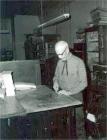2
Andrew King was born in the year 1885 in Manitoba. At an early age, Andrew was exposed to wood working. His parents were Scottish Immigrants, and his father came to Canada to carry on his vocation of building contractor.4
The EquipmentThe presses used were mostly hand operated and of simple design. As a matter of fact, muscle played an important part in the printing trade in those early days.
The most important of all improvements to the mechanical process of printing was the invention of the inking roller both in the formula of its rubber-like composition and its cylindrical shape which invested it with continuity of revolving motion and providing it with greater coverage. (Excerpt from Paper, Pen and Ink by Andrew King, Pg 13)
With the advance in engineering skills bringing about the assembly of cylinder, gears, cams, rollers and rotating parts, the cylinder press was invented - a machine to which power could be applied with greater speed of operation. (Excerpt from Paper, Pen and Ink by Andrew King, Pg 14)
So at the turn of the century the average equipment in the country newspaper office in regard to machinery was a hand operated old style newspaper press, a platen press for job printing and a small paper cutter - the minimum equipment with which the shop could operate.
It was into such a plant that the young country boy - as did dozens of others - went to "learn" the printing and newspaper business. (Excerpt from Paper, Pen and Ink by Andrew King, Pg 15)
5
Andrew King Carving a Wood Block Melville-Ness Collection Saskatchewan Archives Board S-MN-B 40821950

6
First Wood CarvingFrom the very first, the books interested me. Wonder and enquiry followed as to how they were printed and bound and by what manner of means the beautiful gold lettering was stamped on their covers.
It followed that every bit of technical information available was collected and perused. With a pocket knife attempts were made to carve letters on the ends of little bits of wood to reproduce type. The results were no doubt atrocious but the experience brought familiarity with the correct formation of letters as used in printing. It was all good fun and in a sense rewarding. (Excerpt from Paper, Pen and Ink by Andrew King, Pg 17)
8
"His Dad was a master carpenter and grandpa liked to work with his tools, did carving and was really into the printing idea. He pioneered this whole thing with wood blocks. He could do a side of a barn with three colors. Grandpa and dad cut the blocks to print. It was a unique system. At the University of Toronto, they said that at the time, his one of the three distinct print - the other being the cree language and the Cartier font - .. he was way ahead of his time in many things."Campbell King
9
First Day of WorkIt just happened that the country boy began his duties on the day the weekly newspaper was to be printed. Because of the departure of the former apprentice, the staff was short-handed. It consisted then of two partners, owners of the business.
Typesetting of the news to fill the columns was much in arrears. By the time this had been completed, the forms made up and printing of the small edition was done, the hands of the clock indicated 4 a.m.
Nine additional hours had been put in during the
night over the regular work hours. There was no payment for overtime, no coffee breaks, and no complaining. It was simply accepted as part of employment that the newspapers must be mailed by a certain hour no matter how much extra time was required.
Yet the little staff of three was back to work four hours later, ready to put in the regular day's contribution of nine hours. Fifty-four hours was presumed to constitute a full week's work.
Fortunately, the first night's experience was not repeated, though it was a rare occasion when some overtime was not worked, in order that the paper could be printed and mailed on time. (Excerpt from Paper, Pen and Ink by Andrew King, Pg 18-19)
11
First EmployersOne day, Mr. Barclay opened the following conversation:
"Andy, what do you want to do after you learn the trade? Do you want to work for someone else or own a business?"
"Well, Mr. Barclay, I would like to own a business."
"Fine, and what kind of business."
"One like this one of yours, Mr. Barclay. A weekly newspaper and job printing business. I think I would be quite happy with that."
The right flavor of his final remark can only be properly expressed by reproducing his Scottish accent: "Aye, Andy, I ken what ye are thinkin'. Ye can see the money comin' in but ye dinna see it geain' oot."
In later years this sage remark was often recalled with full appreciation of a viewpoint commonly held by those unacquainted with the economics of the operation of any type of business.
It is an expression of a hard fact that most weekly newspapermen became intimate with as they pursued their vocation in the small towns and villages on the prairies. (Excerpt from Paper, Pen and Ink by Andrew King, Pg 31)



